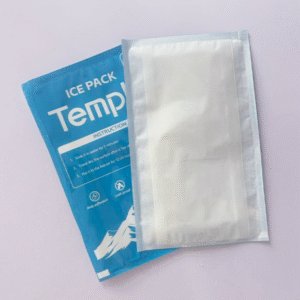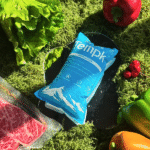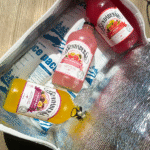Lorsque vous devez conserver des produits congelés solides pendant le transport, vous n'avez pas besoin de compter sur de la glace humide en désordre ou sur des blocs dangereux de glace carbonique. UN feuille de glace carbonique réutilisable est un coussin de refroidissement flexible que vous trempez, congeler et couper à la bonne taille. Contrairement aux blocs rigides, ces feuilles contiennent des cellules scellées remplies de polymères super absorbants qui peuvent maintenir températures ultra froides jusqu'à –21 °C jusqu'à 24 heures. Ils se subliment directement en gaz carbonique, pour que vos colis restent au sec, et ils peuvent être réhydratés et recongelés plusieurs fois pour des économies à long terme. Ce guide explique le fonctionnement des feuilles de glace carbonique réutilisables., comment les dimensionner et les utiliser en toute sécurité, et pourquoi ils constituent un investissement intelligent pour vos opérations de chaîne du froid.
Comment fonctionnent les feuilles de glace carbonique réutilisables et ce qui les différencie? Nous explorerons leur construction en couches et expliquerons comment les cellules scellées et les polymères super absorbants assurent un refroidissement constant à -21 °C..
Comment dimensionner et organiser les feuilles pour des performances optimales? Apprenez le 1:1 formule de dimensionnement, ajustements saisonniers, et en haut, configurations surround et hybrides qui étendent le refroidissement à 72 heures.
Quelles directives de sécurité et réglementaires s'appliquent? Comprendre la ventilation, étiquetage, POINT 49 Exigences du CFR et règles des transporteurs pour expédier de la neige carbonique de manière responsable.
Comment les feuilles de glace carbonique réutilisables se comparent-elles aux packs de gel et aux matériaux à changement de phase (PCMS)? Découvrez les avantages et les inconvénients de chaque réfrigérant et découvrez quand les packs hybrides ont du sens.
Quoi 2025 les tendances façonnent l’emballage de la chaîne du froid? Explorez des innovations comme l'isolation écologique, Surveillance de l'IoT et logistique basée sur l'IA qui améliorent les performances et la durabilité.
Qu'est-ce qu'une feuille de glace carbonique réutilisable et comment ça marche?
Les feuilles de glace carbonique réutilisables sont des tampons flexibles que vous trempez dans l'eau., congeler et couper à la bonne taille pour garder les expéditions congelées. Contrairement aux blocs solides, ils commencent aussi minces, matériaux semblables à du papier composés de petites cellules carrées. Lorsqu'il est immergé dans l'eau, les cellules absorbent l'humidité et gonflent dans des poches de gel; après congélation, ils fournissent une, températures ultra froides jusqu'à –21 °C jusqu'à une journée. Parce que l'eau est enfermée dans des cellules scellées, la feuille se sublime en dioxyde de carbone plutôt que de fondre en flaques d'eau, garder les colis au sec.
Construction et matériaux en couches
Les feuilles de glace carbonique réutilisables se composent généralement de trois couches:
| Couche | Composition | Rôle dans le refroidissement | Ce que cela signifie pour vous |
| Couche externe | Polyéthylène durable ou tissu non tissé | Fournit une barrière protectrice et permet à la feuille d'être coupée ou enveloppée sans se déchirer | Assure la durabilité pendant le transport et plusieurs cycles de gel-dégel |
| Noyau absorbant | Polymères super absorbants qui transforment l'eau en gel | Retient l'eau, gèle pour former de la glace et maintient des températures ultra froides | Permet un refroidissement constant à –21 °C jusqu'à 24 heures |
| Structure cellulaire | Grille de cellules scellées qui évite les fuites et permet la flexibilité | Empêche les fuites de gel et permet de couper les feuilles à différentes tailles | Permet d'enrouler facilement des objets irréguliers et de réutiliser la feuille plusieurs fois |
La structure cellulaire est essentielle à la flexibilité de la feuille. Une fois hydraté, le film se transforme d'une fine feuille en un tapis pliable qui peut s'adapter aux produits. Ses cellules scellées empêchent les fuites de gel, permettant plusieurs cycles de congélation-dégel et réduisant les déchets. Chaque plaque de glace carbonique Techni Ice HDR, Par exemple, comprend 24 cellules à quatre plis—deux feuilles textiles intérieures contenant le polymère réfrigérant et deux feuilles de plastique haute densité, ce qui le rend approuvé par la FDA pour le contact avec les aliments.
Principales caractéristiques et avantages
Les feuilles de glace carbonique réutilisables offrent de nombreux avantages par rapport aux réfrigérants traditionnels:
Rétention prolongée du froid: Les feuilles individuelles maintiennent des températures aussi basses que –21 °C jusqu'à 24 heures. Les configurations surround ou hybrides peuvent étendre le refroidissement à 36–72 heures.
Aucun résidu d'eau: Pendant que le drap se réchauffe, la neige carbonique se sublime en dioxyde de carbone plutôt que de fondre, prévenir les emballages détrempés et la contamination.
Réutilisabilité: Les feuilles peuvent être réhydratées et recongelées plusieurs fois, offrant des économies de coûts à long terme et réduisant les déchets environnementaux.
Flexibilité: Les feuilles peuvent être coupées pour s'adapter à différentes tailles de contenants et enroulées autour de formes irrégulières., maximiser le contact de refroidissement.
Rangement léger: Les feuilles sèches sont fines et légères avant hydratation, économiser de l'espace de stockage et réduire les frais d'expédition.
Approbation de la FDA et du gouvernement: Les packs de glace carbonique réutilisables et robustes comme Techni Ice sont brevetés au niveau international et ont l'approbation de la FDA pour une utilisation sûre avec des aliments et des denrées périssables.. Des organisations telles que le ministère de la Défense leur font confiance, compagnies aériennes et services médicaux dans le monde entier.
Comment les feuilles de glace carbonique des États-Unis améliorent l'efficacité de la livraison
Parce que les feuilles de glace carbonique réutilisables ne contiennent pas d'eau liquide, ils éliminent les dégâts associés à la fonte des glaces. Les packs de glace ou de gel humides traditionnels fondent et peuvent pénétrer à travers les emballages en carton., endommager les étiquettes et compromettre la qualité des produits. Les calottes carboniques se subliment en gaz CO₂, préserver l’intégrité structurelle de l’emballage. Ils offrent des températures de surgélation constantes, ce qui les rend idéaux pour expédier des viandes congelées, fruits de mer et produits pharmaceutiques à travers le pays. Par exemple, un distributeur de fruits de mer du Colorado a utilisé ces feuilles pour expédier des filets de saumon en Floride pendant l'été; en disposant les feuilles autour du produit et en isolant avec de la mousse, le poisson est arrivé encore congelé et exempt de dommages dus à la condensation.
Conseils pratiques pour hydrater et congeler
Bien s'hydrater: Plongez la feuille dans l'eau pendant 10 à 15 minutes jusqu'à ce que chaque cellule gonfle. Un trempage excessif gaspille l’eau, tandis que le trempage réduit la capacité de refroidissement.
Congeler complètement: Placer la feuille hydratée à plat au congélateur à –18 °C ou moins pendant au moins 12 heures avant l'utilisation.
Couper et envelopper: Utilisez des ciseaux pour couper le long des lignées cellulaires afin de les ajuster autour des produits ou des parois de la boîte.. Assurer une couverture complète pour un refroidissement uniforme.
Couper correctement: Placez la plaque de glace carbonique sur les produits surgelés afin que l'air froid descende. Pour des temps de transit plus longs, tapisser les côtés et le fond avec des feuilles supplémentaires.
Réutiliser de manière responsable: Après l'expédition, laisser le CO₂ résiduel se dissiper dans un endroit bien ventilé, puis rincez et recongelez la feuille.
Exemple du monde réel: Un service de kits repas du Midwest a commencé à utiliser des feuilles de glace sèche pour les livraisons à travers le pays. En hydratant, couper et superposer des feuilles autour des steaks et des légumes scellés sous vide, ils ont éliminé les cartons détrempés, consommation de glace réduite de 30 %, et amélioration de la satisfaction client.
Comment calculer et utiliser des feuilles de glace carbonique réutilisables pour votre envoi?
Pour garantir que les produits restent congelés sans ajouter de poids ou de coûts inutiles, vous devez dimensionner et disposer correctement les plaques de glace carbonique. Un simple 1:1 Le rapport entre le poids de la glace carbonique et le poids du produit constitue un point de départ pour les expéditions jusqu'à 48 heures. Par exemple, expédition 8 des livres de viande congelée nécessiteraient environ 8 livres de glace carbonique. Ajustez cette référence en fonction des températures saisonnières, complexité du tracé et qualité de l’isolation.
Formule de dimensionnement et ajustements saisonniers
La formule de dimensionnement prend en compte les facteurs qui influencent la sublimation et la perte thermique:
Calcul de base: Multipliez le poids du produit par 1.0 pour estimer le poids initial de la couche de glace carbonique.
Facteur saisonnier: Ajouter 35 % en supplément en été, 15 % pour le printemps/l'automne et rien pour l'hiver.
Facteur d'itinéraire: Ajouter 10 % pour les itinéraires multi-hand off ou 15 % pour les voies chaudes; ajouter zéro pour les itinéraires directs.
Facteur d'isolation: Soustraire 10 % lorsque vous utilisez une isolation de qualité supérieure et 25 % lors de l'utilisation de panneaux isolés sous vide.
Formule combinée: Poids de la glace carbonique = Poids du produit × (1 + Saison + Itinéraire + Isolation).
| Poids du produit | Commencer la glace sèche (1:1) | Ajouts (Saison/Itinéraire/Isolation) | Ce que cela signifie pour vous |
| 4 kg | 4–5 livres | Ajouter 35 % en été et 10 % pour plusieurs transferts; soustraire 10 % avec une isolation haut de gamme | Assure une retenue fiable de 24 à 36 heures pour les petits envois |
| 8 kg | 8–10 lb | Ajouter jusqu'à 15 % pour les voies chaudes ou les transferts multiples; soustraire 25 % avec panneaux à vide | Prend en charge les expéditions de 36 à 60 heures avec une isolation améliorée |
| 12 kg | 12–15 lb | Pour des conditions extrêmement chaudes, additionner à 35 %; l'isolation de qualité supérieure réduit le poids de la glace carbonique de 20 à 25 % | Maintient les conditions gelées pour 48 heures ou plus |
Stratégies de mise en page: Haut, Surround et hybride
La façon dont vous disposez les calottes carboniques affecte le taux de sublimation et la durée de refroidissement. Trois mises en page courantes incluent:
Meilleur emplacement: Placer des feuilles au-dessus des produits permet d'obtenir des taux de sublimation de 8 à 12 % par 24 heures et maintient les températures pendant 24 à 36 heures. Utilisez cette disposition pour les courts trajets ou lorsque l'espace est limité.
Placement surround: Le fait de recouvrir tous les côtés du produit réduit la sublimation à 6-9 % et prolonge le refroidissement jusqu'à 36 à 60 heures. Idéal pour les produits pharmaceutiques sensibles ou les fruits de mer de grande valeur.
Disposition hybride: La combinaison du placement sur le dessus et sur le côté donne les meilleures performances, avec une sublimation aussi basse que 5–8 % et durées de refroidissement de 48 à 72 heures. Choisissez cette disposition pour les expéditions longue distance ou lorsque les conditions ambiantes sont extrêmes.
Conseil: Utilisez une isolation de qualité supérieure telle que des panneaux sous vide ou de la mousse EPS pour réduire davantage la sublimation.. Les enregistreurs de température en temps réel et les analyses basées sur l'IA peuvent vous aider à affiner votre configuration et à optimiser l'utilisation de la glace carbonique..
Tirer parti des données et de la technologie
Les plates-formes logistiques basées sur l'IA analysent les données historiques d'expédition et les enregistrements de température ambiante pour prédire les taux de sublimation et optimiser les quantités de neige carbonique. Les dispositifs de surveillance en temps réel peuvent vous alerter des écarts, permettant une intervention rapide pour éviter la détérioration. Le partenariat avec des experts de la chaîne du froid garantit l'accès aux dernières meilleures pratiques et technologies.
Quelles directives de sécurité et réglementaires s'appliquent à l'expédition de feuilles de glace carbonique?
L'expédition de neige carbonique aux États-Unis est soumise à des réglementations strictes pour protéger les manutentionnaires., transporteurs et destinataires. La Food and Drug Administration (FDA) exige des systèmes de fermeture des conteneurs pour protéger les produits de la contamination. Les États-Unis. Ministère des Transports 49 Partie CFR 173.196 et 173.199 préciser l'emballage des échantillons de diagnostic et des substances infectieuses, y compris triple emballage (prise primaire, récipient secondaire et emballage extérieur). Transporteurs tels qu'UPS, FedEx et USPS imposent des limites sur le poids de la glace carbonique et exigent un étiquetage spécifique.
Lignes directrices sur la ventilation et les conteneurs
Conteneurs de ventilation: La glace sèche sublimait le dioxyde de carbone, qui peut créer une pression dans des conteneurs scellés. Ne scellez jamais de glace carbonique dans des récipients hermétiques ou en verre.; utilisez des boîtes en mousse EPS ventilées ou des panneaux isolés sous vide à l'intérieur de boîtes en carton robustes pour permettre au gaz de s'échapper.
Contenu séparé: Gardez le contenu séparé de la neige carbonique pour éviter les dommages par contact direct et maintenir la distribution du froid.. UPS recommande 5 à 10 livres de neige carbonique par 24 heures en fonction de la densité d'isolation.
Ajouter un supplément pour les retards: Ajoutez toujours de la neige carbonique supplémentaire pour couvrir les retards inattendus.
Exigences en matière d'étiquetage et de documentation
Toutes les expéditions de glace carbonique nécessitent un étiquetage clair. Les colis doivent porter la mention « Dioxyde de carbone, Solide, UN1845" et indiquer le poids net de neige carbonique en kilogrammes. Les compagnies aériennes limitent la glace carbonique dans les bagages des passagers à 2.5 kg (5.5 kg) et nécessitent une classe 9 étiquette de danger pour les colis dépassant 30 kg. UPS et FedEx n'exigent pas de déclaration de marchandises dangereuses si la neige carbonique est la seule matière dangereuse, mais des étiquettes et une documentation appropriées restent essentielles. USPS autorise uniquement les expéditions nationales et exige un étiquetage indiquant le contenu et le poids net de glace carbonique.
| Transporteur/Règlement | Règles clés | Ce que cela signifie pour vous |
| FDA 21 CFR 211.94 (b) | Les contenants doivent protéger les médicaments de la contamination externe | Utiliser des emballages secondaires étanches et des boîtes extérieures isolées pour les produits pharmaceutiques |
| POINT 49 CFR 173.199/173.196 | Triple emballage requis pour les échantillons de diagnostic | Placez des feuilles de glace carbonique à l'extérieur du récipient principal afin que le CO₂ puisse s'échapper. |
| Hauts | Utiliser des conteneurs EPS ventilés; 5–10 lb par 24 h; ajouter un supplément pour les retards | Laissez les évents ouverts et évitez de trop coller; calculer la glace carbonique en fonction de la densité du PSE |
| Compagnies aériennes (Iata) | Étiquette avec UN1845, afficher le poids net; 2.5 kg limite pour les bagages des passagers | Pour les envois plus importants, travailler avec les services de fret et remplir les documents IATA |
| USPS (Instruction d'emballage 9A) | Envois nationaux uniquement; étiquette avec le contenu et le poids de la glace carbonique | Confirmer que l'itinéraire est national; respecter la limite de poids; inclure une étiquette de danger |
Liste de contrôle de sécurité pour la manipulation de glace carbonique
Conteneurs de ventilation pour permettre au gaz de s'échapper; ne placez jamais de glace carbonique dans un récipient en verre ou en métal scellé.
Portez un équipement de protection y compris des gants et des lunettes isolants pour prévenir les engelures et les blessures aux yeux.
Utilisez une isolation solide comme de la mousse EPS ou des panneaux sous vide dans une boîte en carton.
Étiquetez clairement les colis avec l'ONU 1845 désignation et poids net de glace carbonique.
Poids du document et ajoutez de la neige carbonique supplémentaire pour couvrir les retards potentiels.
Former le personnel sur la manipulation de glace carbonique, Risques d'exposition au CO₂ et interventions d'urgence; une formation est requise pour toute personne manipulant de la neige carbonique.
Exemple de cas: Un laboratoire de diagnostic de New York a expédié des échantillons de sang en Californie à l'aide de feuilles de glace carbonique. En suivant la règle du triple emballage du DOT et en étiquetant la boîte avec l'ONU 1845 étiquette et poids net de glace carbonique, ils ont veillé à ce que les échantillons arrivent congelés et passent l'inspection réglementaire sans problème.
Feuilles de glace sèche réutilisables, packs de gel ou feuilles PCM: Qui est le meilleur?
Le choix du bon réfrigérant dépend de la plage de température de votre produit, durée de l’expédition et objectifs de durabilité. Packs de gel traditionnels, feuilles de glace carbonique et matériau à changement de phase (PCM) les feuilles ont chacune des caractéristiques distinctes.
Analyse comparative
| Réfrigérant | Plage de température | Durée de refroidissement | Risque de fuite | Réutilisabilité | Durabilité | Implications pratiques |
| Packs de gel traditionnels | 0 °C à 5 °C | Jusqu'à 6 heures | Modéré; le gel peut couler lorsqu'il est percé | Limité; souvent à usage unique | Faible; déchets plastiques générés | Idéal pour les produits réfrigérés comme les salades ou les boissons, mais ne convient pas à la congélation |
| Feuilles de glace sèche aux États-Unis | –21 °C (pour jusqu'à 24 h) | 24–72 heures selon aménagement | Très faible; la sublimation ne laisse aucun liquide | Oui; réhydraté et recongelé plusieurs fois | Modéré; Du CO₂ est libéré mais les emballages sont réutilisables | Idéal pour les produits surgelés et les expéditions de nuit; nécessite des étiquettes de danger et une ventilation |
| Feuilles PCM | –20 °C à 5 °C | 48–72 heures | Minimal; Les PCM ne fuient pas une fois scellés | Hautement réutilisable; >500 cycles | Haut; souvent biodégradable et recyclable | Convient aux produits réfrigérés ou moyennement surgelés; évite les étiquettes dangereuses et réduit l’empreinte carbone |
Pourquoi choisir des feuilles de glace carbonique réutilisables?
Les feuilles de glace carbonique réutilisables fusionnent la capacité de congélation de la glace carbonique avec la flexibilité et la durabilité des PCM. Ils contiennent des PCM haute densité qui maintiennent –20 °C à 5 °C, ne coule pas et peut être recongelé des centaines de fois. Ces draps se comportent comme des thermostats intelligents, s'adapter aux températures extérieures et réduire les excursions de température en 25 %. Les entreprises utilisant des draps réutilisables ont réduit leurs déchets de 60 %, réduction des coûts d'emballage et diminution des plaintes des clients concernant les problèmes de température.
Conseils pour sélectionner le bon réfrigérant
Identifier les exigences de température: Utilisez des plaques de glace carbonique pour les produits surgelés (en dessous de –10 °C). Choisissez les PCM pour les produits réfrigérés (2 ° C - 8 ° C) et emballages hybrides pour les expéditions nécessitant plusieurs zones de température.
Tenez compte de la durée d'expédition: Pour les envois sous 24 heures, des plaques de glace carbonique peuvent suffire. Pour les expéditions sous 48 à 72 heures, les packouts hybrides ou PCM peuvent réduire la quantité de glace carbonique et les contraintes réglementaires.
Évaluer les objectifs de réutilisation et de durabilité: Si votre entreprise valorise les pratiques d’économie circulaire, optez pour des feuilles PCM réutilisables qui durent 500+ cycles.
Évaluer le coût par rapport à la conformité: La glace carbonique nécessite des étiquettes de danger et une formation; Les PCM évitent les classifications dangereuses mais ont des coûts initiaux plus élevés. Équilibrer la complexité réglementaire et les besoins de refroidissement.
2025 Tendances et innovations dans le domaine de l'emballage sous chaîne du froid
Le secteur de la chaîne du froid évolue rapidement. Les analystes prévoient que le marché mondial de la chaîne du froid atteindra $500 milliards 2025. La croissance est tirée par les produits pharmaceutiques, demande de produits biologiques et d'épicerie en ligne. Entre-temps, le marché des blocs de glace réutilisables est estimé à $800 millions en 2025 et devrait dépasser $1.5 milliards 2033, grandir à un 7 % TCAC. Le marché mondial des réfrigérants d’emballage pour la chaîne du froid est évalué à $1.69 milliards en 2025 et devrait atteindre $2.92 milliards 2032 avec un 8.14 % TCAC.
Dernières innovations et leur importance
Isolation écologique: Les fabricants développent des matériaux d'isolation durables qui réduisent l'impact environnemental tout en améliorant l'efficacité thermique., y compris les mousses biosourcées, panneaux sous vide recyclables et doublures compostables. Ce que cela signifie pour vous: une isolation durable peut réduire les déchets et aligner votre marque sur les objectifs environnementaux.
Surveillance de la température en temps réel: Les capteurs compatibles IoT fournissent des données continues sur la température, humidité et emplacement, permettant une intervention rapide pour éviter la détérioration. Certaines plaques de glace carbonique intègrent des étiquettes RFID ou des étiquettes intelligentes pour suivre l'historique des températures.. Avantage: visibilité améliorée et réponse plus rapide aux écarts.
Logistique pilotée par l'IA: Des algorithmes avancés analysent les données d'expédition pour prédire les taux de sublimation et optimiser les quantités de neige carbonique. Les plateformes d'IA gèrent également le routage pour éviter les retards et les conditions extrêmes. Avantage: des coûts réduits et moins d'excursions de température.
Emballages hybrides: La combinaison de plaques de glace carbonique avec des PCM ou des packs de gel crée plusieurs zones de température au sein d'un seul envoi.. Les configurations hybrides prolongent la durée de refroidissement jusqu'à 72 heures et réduire les taux de sublimation. Avantage: flexibilité pour les charges mixtes.
Indicateurs de durabilité: Les entreprises adoptent les analyses du cycle de vie et le suivi de l'empreinte carbone des emballages.. Les feuilles réutilisables et les PCM peuvent réduire les déchets jusqu'à 60 % et réduire les émissions en 25 %. Avantage: performance ESG améliorée.
Insistance au marché
La demande de solutions fiables pour la chaîne du froid augmente aux États-Unis. Livraison de repas en ligne, Le commerce électronique des produits alimentaires et les médicaments biologiques nécessitent tous un contrôle constant de la température.. De nombreuses entreprises abandonnent les packs de gel à usage unique au profit de feuilles de neige carbonique et de PCM réutilisables afin de réduire l'impact environnemental et les coûts de conformité.. La surveillance en temps réel et l'analyse par l'IA deviennent des attentes de base pour les expéditions de grande valeur. Alors que les transporteurs renforcent les réglementations et que les consommateurs exigent la durabilité, adopter intelligemment, Des solutions de glace carbonique respectueuses de l'environnement seront essentielles pour rester compétitif.
Questions fréquemment posées
Q1: Combien de temps les feuilles de glace carbonique réutilisables gardent-elles les articles congelés?
Selon agencement et isolation, une couche de neige carbonique hydratée maintient –21 °C jusqu'à 24 heures. Les configurations surround ou hybrides peuvent étendre le refroidissement à 36–72 heures.
Q2: Puis-je réutiliser les feuilles de glace carbonique?
Oui. Après que la neige carbonique se soit sublimée, permettre au CO₂ résiduel de se dissiper dans un endroit bien ventilé, puis réhydrater et recongeler la feuille. De nombreuses feuilles résistent à plusieurs cycles de gel-dégel, offrant des économies de coûts à long terme et une réduction des déchets.
Q3: Ai-je besoin d'une déclaration de marchandises dangereuses lors de l'expédition de plaques de neige carbonique?
Pour les expéditions intérieures de marchandises non dangereuses, vous n'avez généralement pas besoin d'une déclaration complète. Cependant, vous devez étiqueter les colis avec « Dioxyde de carbone, Solide, UN1845" et indiquez le poids net de glace carbonique. Les expéditions internationales ou les colis contenant d'autres matières dangereuses peuvent nécessiter une déclaration complète.
Q4: Que dois-je faire si une plaque de glace carbonique entre en contact avec des aliments?
Évitez le contact direct entre la neige carbonique et les aliments. Séparez toujours les feuilles des produits à l'aide de doublures en plastique ou en les plaçant sur le dessus pour garantir un refroidissement uniforme.. Le contact direct peut causer des dommages causés par le froid extrême.
Q5: Comment puis-je me débarrasser des feuilles de glace carbonique usagées?
Laissez les restes de glace carbonique se sublimer dans un endroit bien ventilé, loin des personnes et des animaux domestiques.. Réhydrater et recongeler la feuille si elle est réutilisable; sinon, jetez-le conformément aux directives de recyclage locales.
Q6: Les feuilles PCM réutilisables sont-elles une meilleure option?
Les feuilles PCM réutilisables maintiennent des températures comprises entre –20 °C et 5 °C et peut être recongelé 500 fois. Ils ne nécessitent pas d'étiquettes dangereuses et réduisent les déchets en 60 %, ce qui les rend adaptés aux produits réfrigérés ou moyennement surgelés. Cependant, ils peuvent ne pas atteindre les températures ultra froides des calottes carboniques.
Résumé et recommandations
Principaux à retenir: Les feuilles de glace carbonique réutilisables sont des tampons flexibles que vous hydratez, congeler et couper à la bonne taille pour garder les produits congelés solides pendant le transport. Les cellules scellées remplies de polymères super absorbants offrent des températures ultra froides jusqu'à -21 °C jusqu'à 24 heures. Les configurations surround ou hybrides prolongent le refroidissement jusqu'à 36 à 72 heures. Un dimensionnement approprié suit un 1:1 rapport glace carbonique/poids du produit, ajusté pour la saison, tracé et isolation. Conformité au DOT 49 Réglementation CFR, ventilation, l'étiquetage et la formation à la sécurité sont essentiels. Par rapport aux packs de gel, les feuilles de glace carbonique réutilisables offrent un froid plus profond et une réutilisation; Les PCM offrent une durée plus longue sans étiquettes dangereuses. 2025 les tendances pointent vers une isolation écologique, Surveillance de l'IoT, Logistique pilotée par l'IA et emballages hybrides. Le marché des blocs de glace réutilisables devrait croître de $800 millions en 2025 à plus $1.5 milliards 2033, tandis que le marché des réfrigérants d'emballage pour la chaîne du froid devrait atteindre $2.92 milliards 2032.
Conseils exploitables:
Évaluez les besoins en température de votre produit: Utilisez des plaques de glace carbonique pour les produits surgelés et des PCM pour les produits réfrigérés.. Les solutions hybrides offrent plusieurs zones de température.
Appliquer la formule de dimensionnement: Commencez par un 1:1 rapport glace carbonique/poids du produit et ajustement en fonction des facteurs saisonniers, complexité du tracé et qualité de l’isolation.
Sélectionnez la bonne mise en page: Pour les trajets courts, utilisez le placement supérieur; pour des durées plus longues, choisissez des configurations surround ou hybrides.
Suivre la réglementation: Conteneurs de ventilation, étiqueter les colis avec UN 1845 et poids net, et conforme au DOT 49 Directives spécifiques au CFR et aux transporteurs.
Investissez dans des solutions réutilisables: Réhydrater et recongeler les plaques de glace carbonique pour réduire les déchets; envisager des feuilles PCM pour 500+ réutiliser les cycles.
Tirer parti de la technologie: Utilisez des capteurs IoT et des plateformes logistiques IA pour surveiller la température, prédire la sublimation et optimiser les itinéraires.
Consulter des experts: Collaborer avec des spécialistes de la chaîne du froid et des transporteurs expérimentés dans les expéditions de glace carbonique pour garantir la conformité et l'efficacité.
À propos du tempk
Tempk se spécialise dans les solutions avancées de chaîne du froid pour les États-Unis. marché. Notre Feuilles de glace sèche aux États-Unis, Les produits PCM réutilisables et les conteneurs isothermes sont conçus pour répondre aux réglementations strictes de la FDA et du DOT tout en maximisant les performances de refroidissement.. Nous nous concentrons sur la durabilité en proposant des matériaux recyclables et des produits réutilisables qui réduisent les déchets et les coûts.. Laissez notre équipe expérimentée vous aider à concevoir un système de chaîne du froid optimal, depuis les formules de dimensionnement et les stratégies d'agencement jusqu'à la surveillance en temps réel et la conformité réglementaire..
Appel à l'action: Prêt à améliorer votre chaîne du froid? Contactez l'équipe Tempk pour une consultation sur mesure. Nos experts vous aideront à choisir la bonne combinaison de plaques de glace carbonique, PCM et isolation pour répondre à vos exigences spécifiques en matière de température et à vos objectifs de durabilité.
























